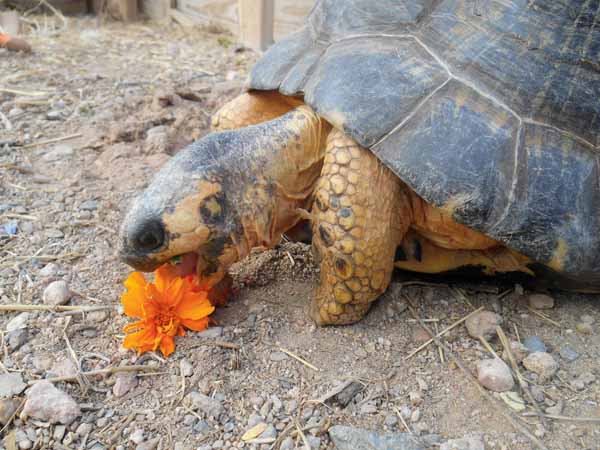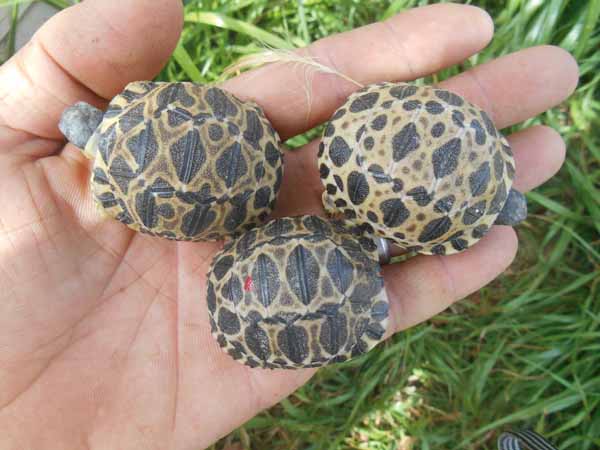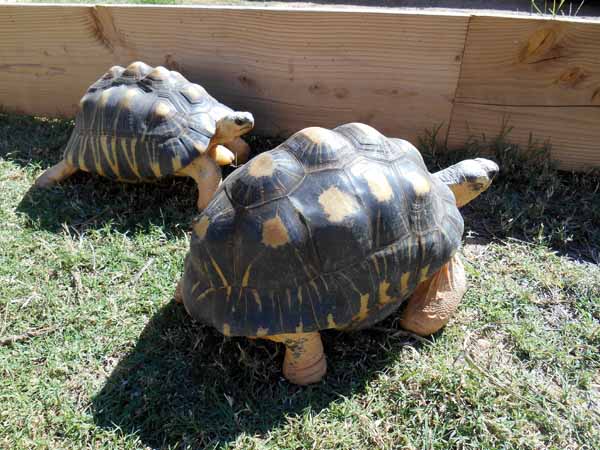Captive breeding makes the critically endangered radiated tortoise available to enthusiasts. There is no vertebrate group facing greater survi
Captive breeding makes the critically endangered radiated tortoise available to enthusiasts.
There is no vertebrate group facing greater survival problems today. Turtles saw the great dinosaurs come and go, and are now facing their own extinction crisis. —John L. Behler, Wildlife Conservation Society
The critically endangered radiated tortoise (Astrochelys radiata) is one of the most sought-after tortoises in the world. Adult radiated tortoises can attain a length of about 16 inches. The skin coloration is typically bright yellow, with black markings on the head. The high-domed shell exhibits radiating yellow lines (the reason for the common name) that run through the jet-black scutes that form the shell.
Read More
Radiated Tortoise Faces Extinction
Human consumption and the pet trade have removed a large number of radiated tortoises from the wild, and within its native range of Madagascar, specimens are only sporadically found. The Convention on International Trade in Endangered Species of Wild Fauna and Flora (CITES) has classified the radiated tortoise an Appendix I species for which there is no legal export or import. While this has helped the tortoise, recovery of wild populations has been slow. Astrochelys radiata still appears in the black market pet trade in Southeast Asia, and human consumption of radiated tortoises remains a major concern in Madagascar, where shells that have been broken open with the flesh scraped out can be found on the sides of roads.

Andrew Hermes
Radiated tortoises should be fed a varied diet, including grasses, weeds, greens, and flower blossoms.
The good news is that captive-bred populations of radiated tortoises are doing increasingly well in the United States and other regions. It is legal to own radiated tortoises in the U.S., though to sell them and transport them across state lines requires a captive-bred wildlife permit from the U.S. Fish and Wildlife Service (see sidebar on page 42). Captive breeding of the radiated tortoise is tracked by the North American Studbook.
How to Get a Captive Bred Wildlife Permit
Obtaining a captive-bred wildlife permit through the U.S. Fish and Wildlife service can be a little intimidating at first, but is easy once you get started. Simply print out and fill in the Captive-Bred Wildlife Registration form found at fws.gov/forms/3-200-41.pdf. Send it to USFWS along with photos of the intended enclosure for the tortoise. As of this writing it costs $200 to obtain the permit, which is valid for five years. Annual updating is required, as well.

Andrew Hermes
As with adults, the shells of hatchling radiated tortoises are very attractive.
Radiated Tortoise Care
They have wonderful personalities and make great pets, but radiated tortoises, like other tortoises, live a long time. Your pet might be with you for up to 60 years or longer, so this must be considered carefully before obtaining one. If you are not committed to providing long-term care, you’re better off not getting a tortoise.
Radiated tortoises thrive best in natural sunlight and fresh air, so they should be kept only by people who live in areas that will allow the tortoises to be kept outside in a secure enclosure. Up to about four hatchlings can be maintained in a 2- by 3-foot enclosure. Adults need a minimum size of about 10 by 15 feet, which could house two or three adults.
I prefer to construct the walls of radiated tortoise enclosures out of wood, in order to preserve the tortoises’ amazing shell coloration and patterns. If bricks or cinderblocks are used, their shells can become scratched or scraped when the tortoises brush up against these rough surfaces. Radiated tortoises will often back up against objects, including enclosure walls, and rock back and forth to scratch themselves, so it’s better for them to do this against wood than rock, cement, etc. (speaking of which, tortoises are very much able to feel contact through their shells, and mine seem to love an occasional shell rub). Enclosure walls should be at least 10 inches tall for adults and 4 inches tall for hatchlings.
Within every enclosure, no matter the size or age of the tortoises being kept in them, there are some must-have items. First and foremost is a well-insulated hide/shelter, to allow the tortoises to escape the elements, including rain, wind and intense heat. Again, I prefer to use wood when constructing these; the shelter should have four walls and a roof, with an easily accessible entrance that can be closed tight. Naturally, you want your tortoise(s) to be able to easily enter and exit the hide without getting stuck. If you live in an area with frequent rain, consider raising the shelter several inches off the ground by attaching legs or some other type of support, with a ramp leading up to the entrance.

ANDREW HERMES
During the day, radiated tortoises are fine in temperatures ranging from 70 to 95 degrees Fahrenheit. Tortoises conserve heat acquired during the day, and it slowly dissipates throughout the evening.
The inside of the hide should be well insulated to provide a dry, warm environment. This can be achieved by using substrates such as hay or cypress mulch, to name a couple. If a heating element or pig blanket is used, there is no need for any additional bedding. If you use a heating device, be sure there is space in the shelter to allow tortoises to escape the heat, if needed. You don’t want them to become overheated.
During the day, radiated tortoises are fine in temperatures ranging from 70 to 95 degrees Fahrenheit. Tortoises conserve heat acquired during the day, and it slowly dissipates throughout the evening. If ambient temperatures drop to less than 55 degrees at night, supplemental heat should be provided.
Other important items for an outdoor tortoise enclosure include a food plate, a water source and abundant plant life that is safe for the tortoises to eat. When supplemental food is offered, it should be placed on a clean plate that is easy for the tortoises to access. This will help ensure that they do not accidentally consume rocks or debris that could cause an intestinal impaction.
While radiated tortoises take in some moisture through the food they consume, this might not be enough water, especially on hot days, so a water source should be provided, as well. This can be as simple as sinking a saucer or dish into the pen’s substrate, making it flush with the ground. The tortoises will drink from it, and probably walk into it, too. They may defecate in it, as well, so be sure water is always kept clean. A permanent pool can be created by digging a shallow impression into the ground and coating it with a thin layer of concrete. After the concrete dries, apply a thin layer of water-proof mortar, which will seal the pool and make it water tight. This type of water source is very easy to clean by simply sweeping the basin out with a broom and refilling it with water.
Plant life provides many benefits in a tortoise enclosure. In addition to being a food source, live plants will provide shade and secure places for tortoises to take refuge in order to feel safe. Hiding areas provided by plants will provide additional areas for tortoises to use to regulate their body temperatures, too.
Captive radiated tortoises are creatures of habit. They will stick to a daily routine of basking, eating, drinking and exploring. By knowing your tortoise’s routine, you can often tell when a health problem may be present, because this often causes a tortoise to deviate from its routine. Their care doesn’t have to be complicated, but as with the care of any living creature, attention to detail is needed to maintain a happy, healthy animal—and hatchling radiated tortoises need a little more attention to detail than adults.
Because they’re so small and housed in temperatures that could approach 95 degrees, hatchling A. radiata can easily become dehydrated. To ensure proper hydration, soak hatchlings every other day. Fill a shallow dish with lukewarm water and place the tortoise in the dish. The water level should reach just beneath the tortoise’s chin. The tortoise will drink the water, and its skin will also absorb the moisture. Most tortoises reserve their water resources until they find another source, so don’t be surprised if a tortoise defecates during the soak. This, in turn, will result in a hungry tortoise, so have food ready to offer after soaking. Proper hydration is also a key factor in smooth shell growth, along with proper diet, exercise and exposure to ultraviolet (UV) light.
A Varied Diet
Offer radiated tortoises a wide variety of supplemental food options in addition to the planted plants in their enclosure. The diet of A. radiata consists of grasses, succulents, flower blossoms, Opuntia cactus (high in fiber and calcium), greens and fruits.
Offering commercial foods such as Mazuri Tortoise Diet, as well as fruit, will also help ensure your tortoise is getting a varied diet. Be careful when offering fruit, however. I have used it without any problems, but use it very sparingly, as too much fruit can cause diarrhea, leading to dehydration in grassland tortoise species.
Edible Foliage for Captive Radiated Tortoises
Grasses: Bermuda, rye, orchid, Kentucky blue grass, tiff, timothy, alfalfa grass, various varieties of fescue
Weeds: chicory, hollyhock, crimson and white clovers, Dichondra, watercress, mallow, dandelion, purslane, common plantain, chickweed
Leaves: butterfly bush, cape honeysuckle, rose, grape, fig, rosemary, squash, sweet potato, ice plant, sea lavender, Hibiscus, carrot, cucumber, strawberry, ferns
Trees: mulberry, guava, banana, pineapple, blackberry, fig, pomegranate,
Cactus and succulents: aloe vera, Opuntia, prickly pear, Christmas cactus, ice plant, Yucca, jade plant, Sedum
Flowers: marigolds, Ruellia, honeysuckle, roses, daisies, Hibiscus, yellow bell, petunias, dandelion, ice plant, pansies, squash
Vines: snail vine, grape vine, rose vine
Produce greens: escarole; endive; frisee; carrot; red leaf, green leaf and romaine lettuce; mustard, collard and turnip greens; parsley; radicchio; mushrooms
Dry food: Bermuda, alfalfa and orchid hay, Mazuri Tortoise Diet
Fruits (limited quantities; see text): mango, papaya, plantain, apple, strawberry, pumpkin, squash, watermelon
Cuttlebone should always be present in the enclosure, and supplemental calcium powder should occasionally be sprinkled onto tortoises’ greens.
With time, captive radiated tortoises will associate their keepers with food, and when it’s feeding time they will approach you with anticipation of getting a treat.
Breeding the Radiated Tortoise
Radiated tortoises can be accurately sexed once they attain a shell length of 11 to 12 inches. It is also around this size that they reach sexual maturity. It is one of the most difficult tortoises to visibly sex. All the usual sexual characteristics, including tail length, gular and anal scutes, plastron shape and anal openings can help determine gender, but these traits may change until the tortoises are 12 inches in length. Therefore, it can be difficult to sex them before then, which frustrates many a keeper.
On average, female A. radiata are able to begin reproducing when they reach between 12 and 14 inches, though egg-laying has been documented when they’re as small as 11 inches. Radiated tortoises do not hibernate, so females are able to produce year round, depending on their captive environment.
In Madagascar, the rainy season signals the start of the breeding season. Therefore, a good way to entice breeding in captive radiated tortoises is to use some type of sprinkler or misting system in the enclosure. On warm days when the mister/sprinklers are operating, mating activity may be observed. A male will initiate this by circling a female, maybe giving her a nudge or two. The male will then mount the female from behind. Like most other species of tortoises, the male will make a grunting sound while mating.
Male radiated tortoises can be somewhat lazy when it comes to exhibiting sexual interest in females. In such cases, separating a male from a female for a few days before reintroducing him should spark his interest. Also, adding an additional male to the enclosure may result in a competitive pushing match, leading to the winner and more dominant male breeding with the female.
The typical clutch size for a female radiated tortoise is three to six eggs. Egg production increases once the tortoises reach 15 to 20 years of age. Another trait of this species that can be frustrating to radiated tortoise breeders is that females will produce a few clutches when they first attain maturity, but then slow or stop egg production for a while, until they are a few years older.
Sometimes urinating on the substrate to soften it, gravid females will use their hind legs to excavate a nest measuring about 5 inches in diameter and 6 inches deep in which to lay eggs. When removing radiated tortoise eggs from the nest to an egg box containing the incubation medium (an appropriately sized Tupperware container with air holes drilled into the lid can be used), be sure to keep them oriented in the position in which they were laid. Turning them could result in the death of the developing embryos inside. I bury my radiated tortoise eggs in a 3 to 4-inch layer of moist vermiculite for incubation.
In their natural environment, A. radiata eggs experience diapause, meaning they go through a cooling period before they begin developing. From start to finish, it takes about 120 days from laying to hatching. For the first 30 days, I incubate the eggs at 60 to 66 degrees, then at 86 degrees for the rest of the duration. I recommend keeping them at room temperature for 12 to 24 hours immediately after they’re laid, prior to incubating at the cooler temperatures, and then again prior to raising the incubation temperature to 86 degrees. This will help to temper the transition between temperatures.
Humidity is crucial during the incubation process and even more important the weeks before and during hatching. A humidity level of 50 percent during incubation is recommended, with an increase to 75 percent by the time they hatch about 120 days after being laid.
With continued captive-breeding efforts, populations of this amazing tortoise will hopefully continue to thrive in captive environments—and hopefully, someday, in nature once again.
This article is dedicated to Greg Schmitt. The good work of private tortoise caretakers like Greg will help maintain and preserve Astrochelys radiata for future generations.
Andrew Hermes is a tortoise enthusiast who maintains one of the most diverse groups of tortoise species in the U.S. He shares his tortoises and experiences via his website, ArizonaTortoiseCompound.com.



